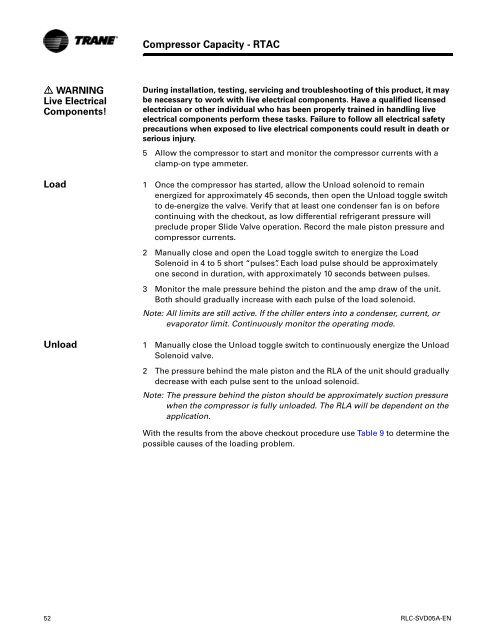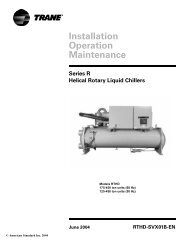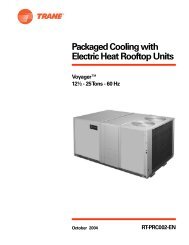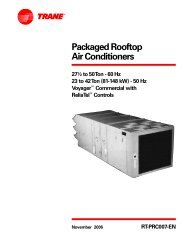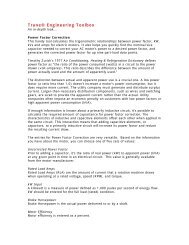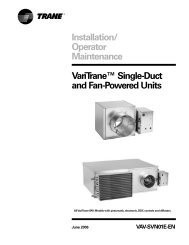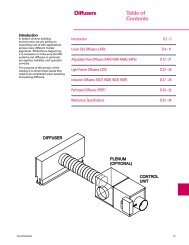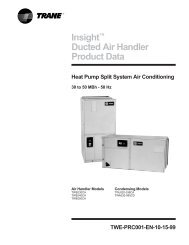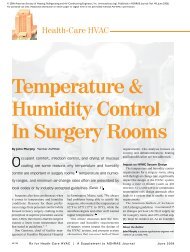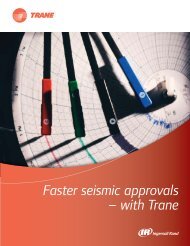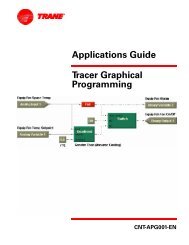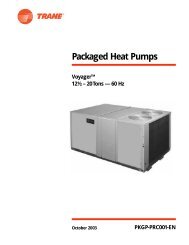RTHD and RTAC - Trane
RTHD and RTAC - Trane
RTHD and RTAC - Trane
Create successful ePaper yourself
Turn your PDF publications into a flip-book with our unique Google optimized e-Paper software.
� WARNING<br />
Live Electrical<br />
Components!<br />
Compressor Capacity - <strong>RTAC</strong><br />
During installation, testing, servicing <strong>and</strong> troubleshooting of this product, it may<br />
be necessary to work with live electrical components. Have a qualified licensed<br />
electrician or other individual who has been properly trained in h<strong>and</strong>ling live<br />
electrical components perform these tasks. Failure to follow all electrical safety<br />
precautions when exposed to live electrical components could result in death or<br />
serious injury.<br />
5 Allow the compressor to start <strong>and</strong> monitor the compressor currents with a<br />
clamp-on type ammeter.<br />
Load 1 Once the compressor has started, allow the Unload solenoid to remain<br />
energized for approximately 45 seconds, then open the Unload toggle switch<br />
to de-energize the valve. Verify that at least one condenser fan is on before<br />
continuing with the checkout, as low differential refrigerant pressure will<br />
preclude proper Slide Valve operation. Record the male piston pressure <strong>and</strong><br />
compressor currents.<br />
2 Manually close <strong>and</strong> open the Load toggle switch to energize the Load<br />
Solenoid in 4 to 5 short “pulses”. Each load pulse should be approximately<br />
one second in duration, with approximately 10 seconds between pulses.<br />
3 Monitor the male pressure behind the piston <strong>and</strong> the amp draw of the unit.<br />
Both should gradually increase with each pulse of the load solenoid.<br />
Note: All limits are still active. If the chiller enters into a condenser, current, or<br />
evaporator limit. Continuously monitor the operating mode.<br />
Unload 1 Manually close the Unload toggle switch to continuously energize the Unload<br />
Solenoid valve.<br />
2 The pressure behind the male piston <strong>and</strong> the RLA of the unit should gradually<br />
decrease with each pulse sent to the unload solenoid.<br />
Note: The pressure behind the piston should be approximately suction pressure<br />
when the compressor is fully unloaded. The RLA will be dependent on the<br />
application.<br />
With the results from the above checkout procedure use Table 9 to determine the<br />
possible causes of the loading problem.<br />
52 RLC-SVD05A-EN


